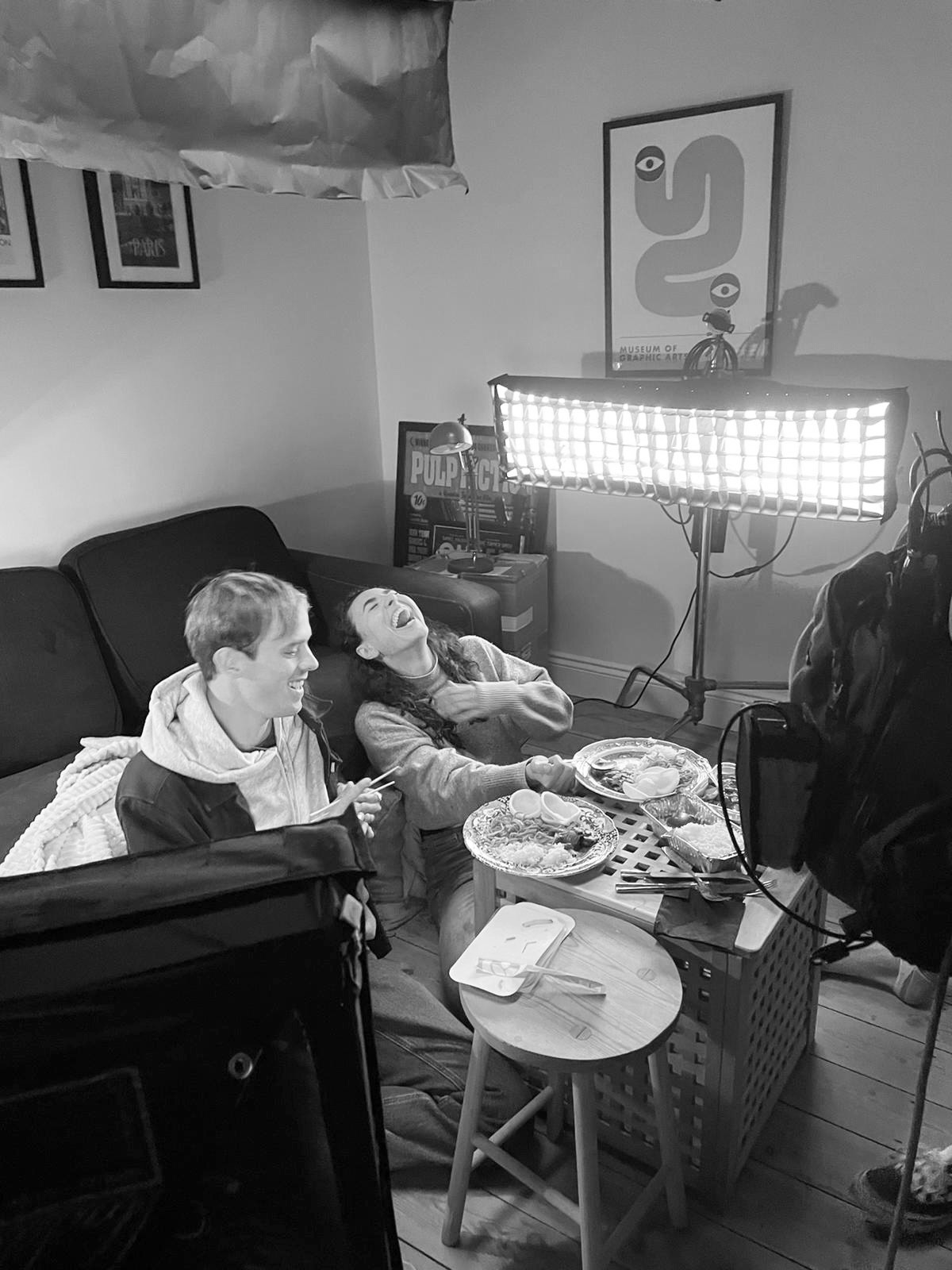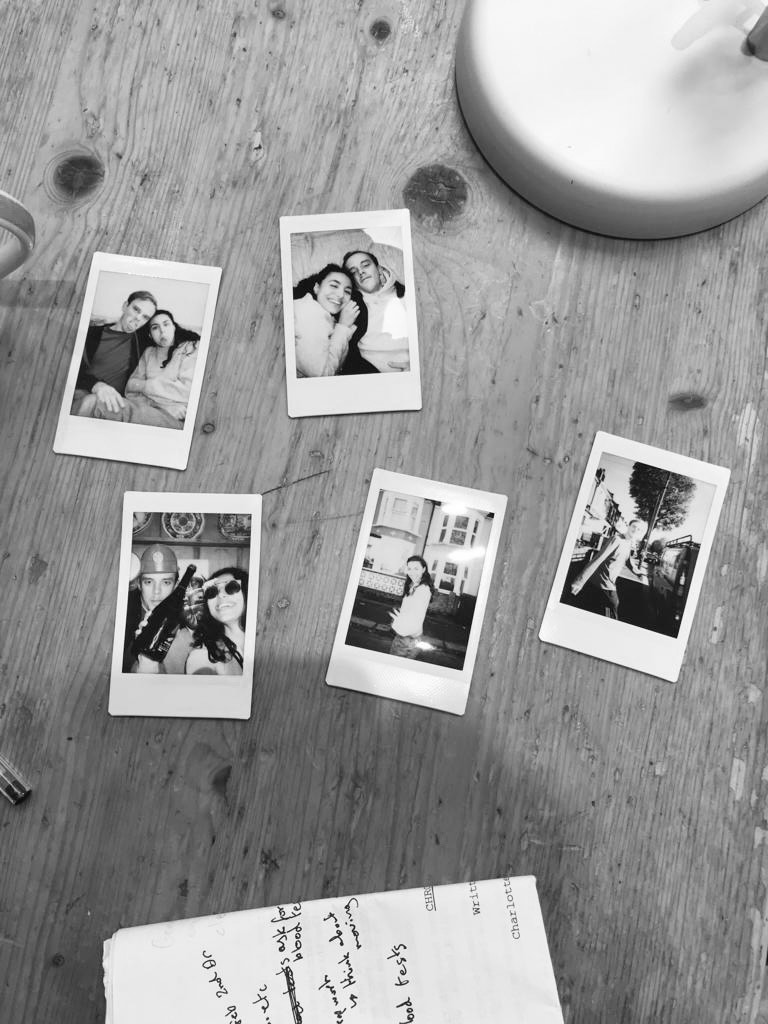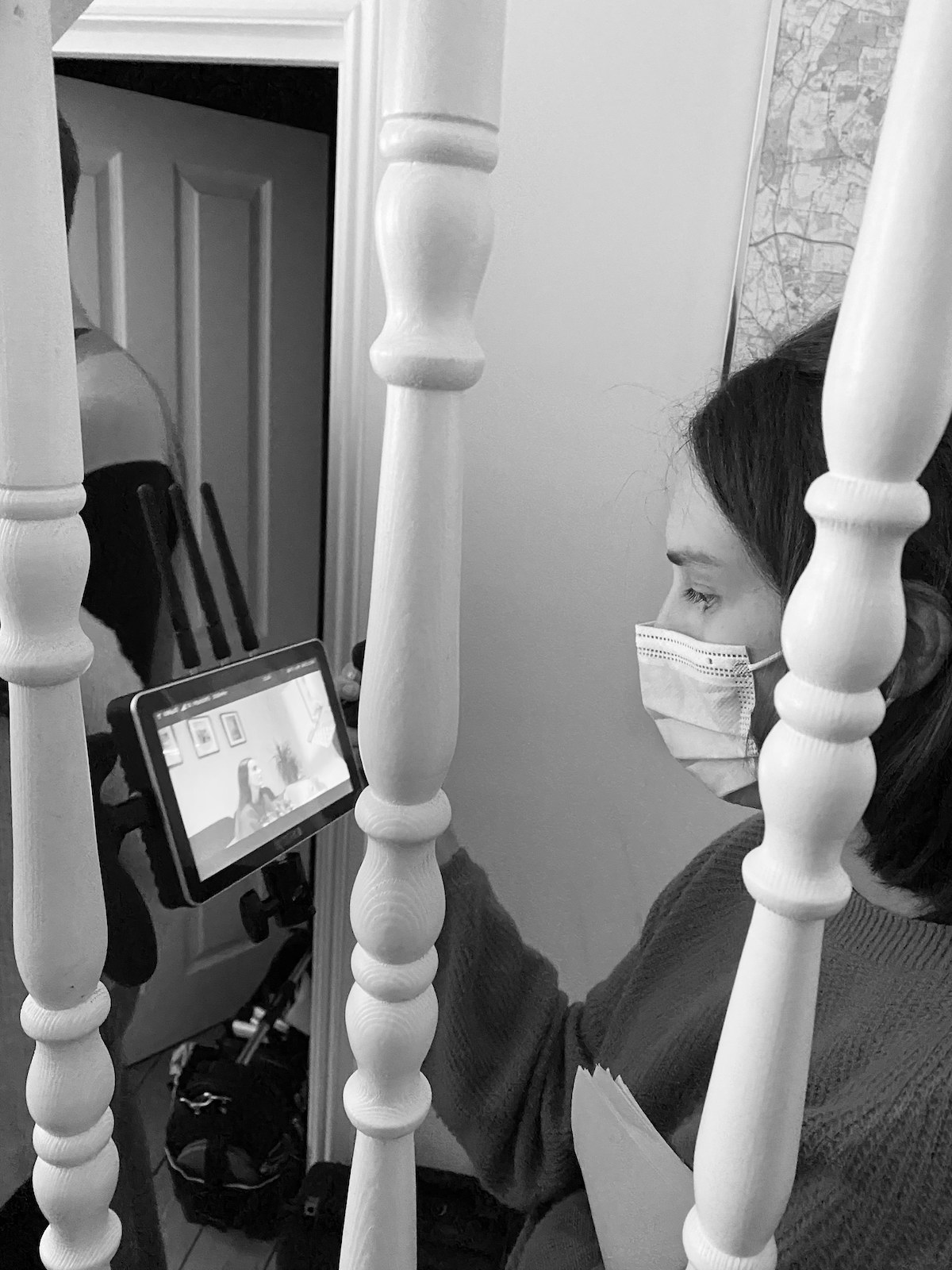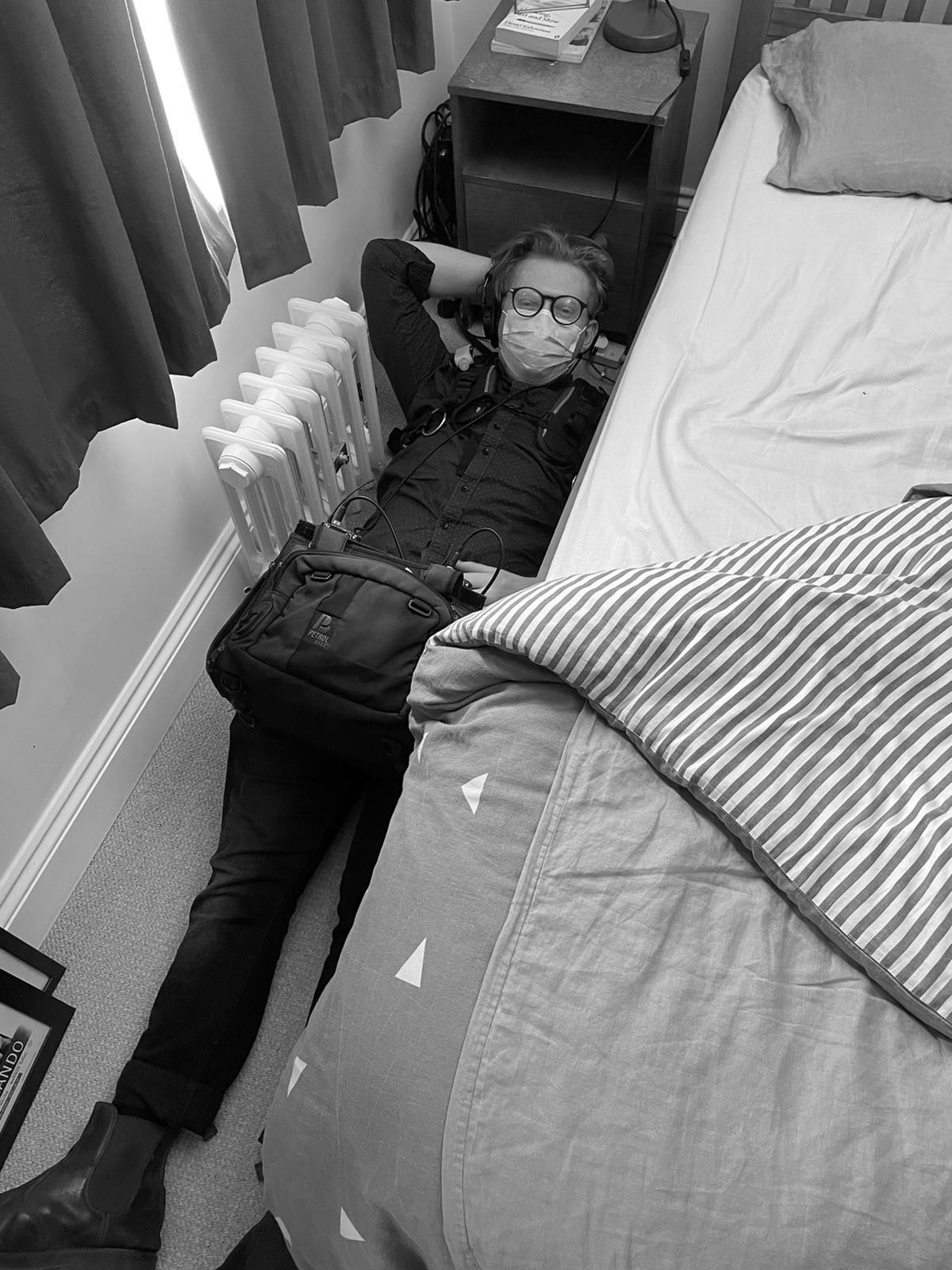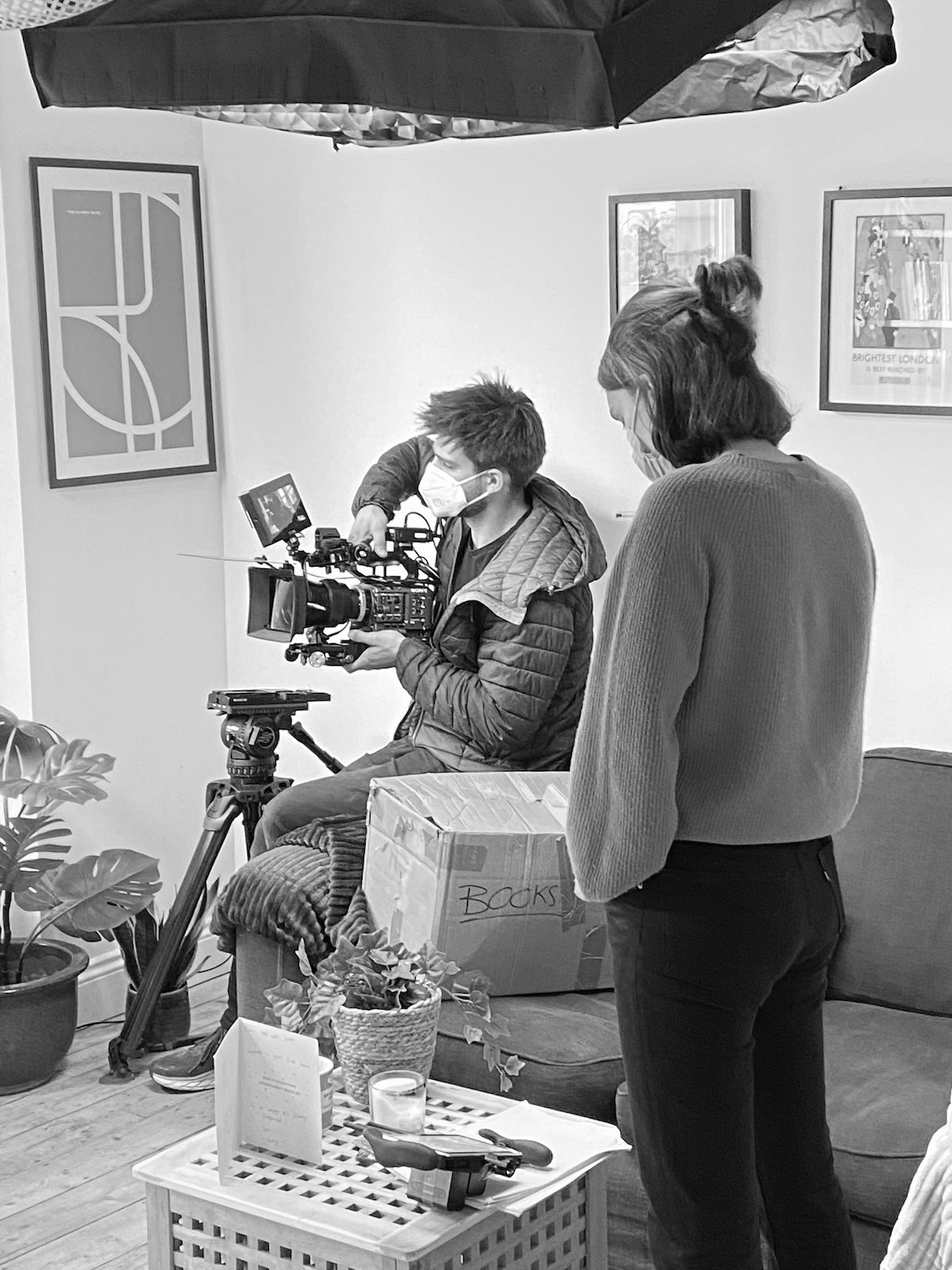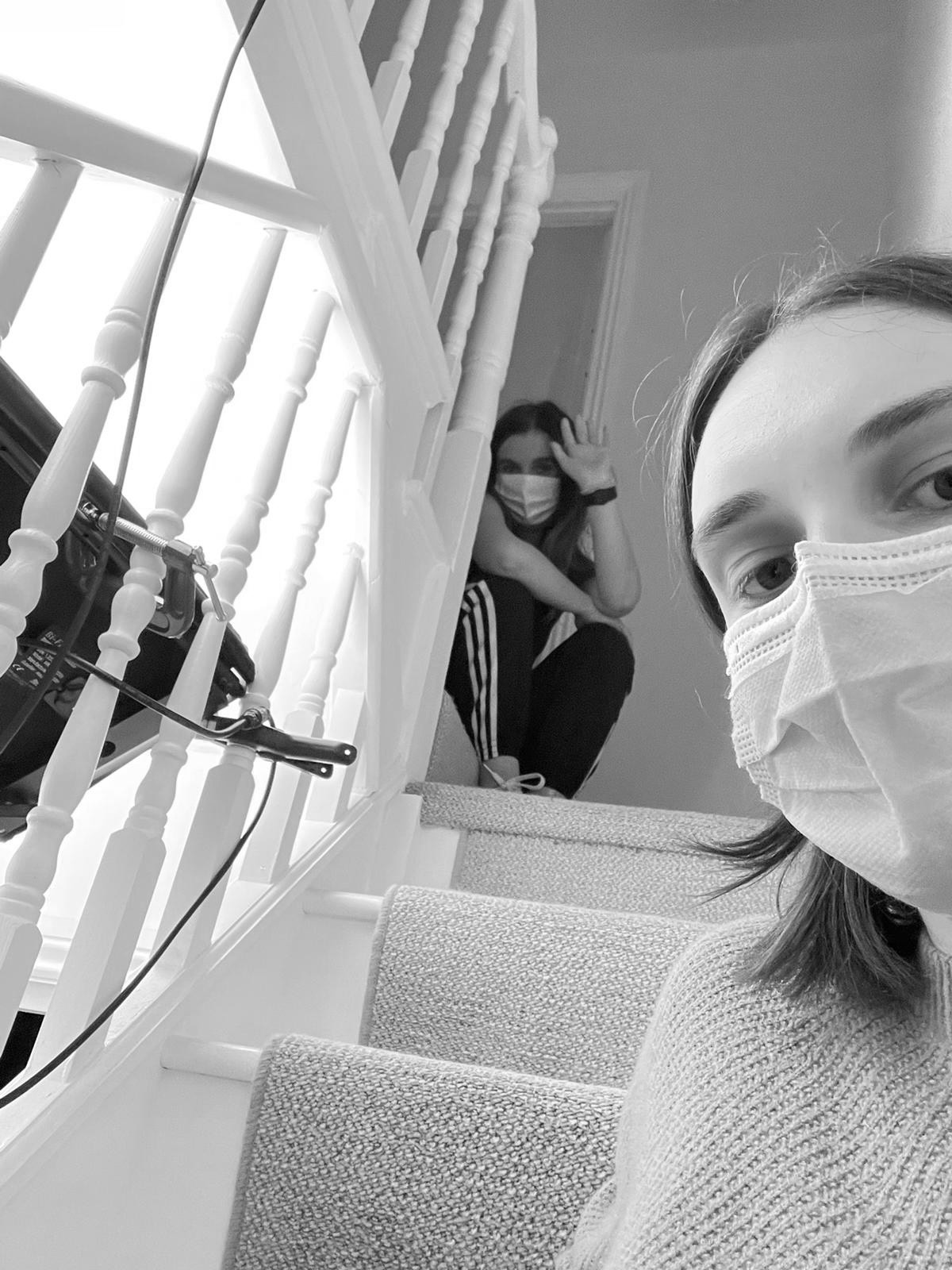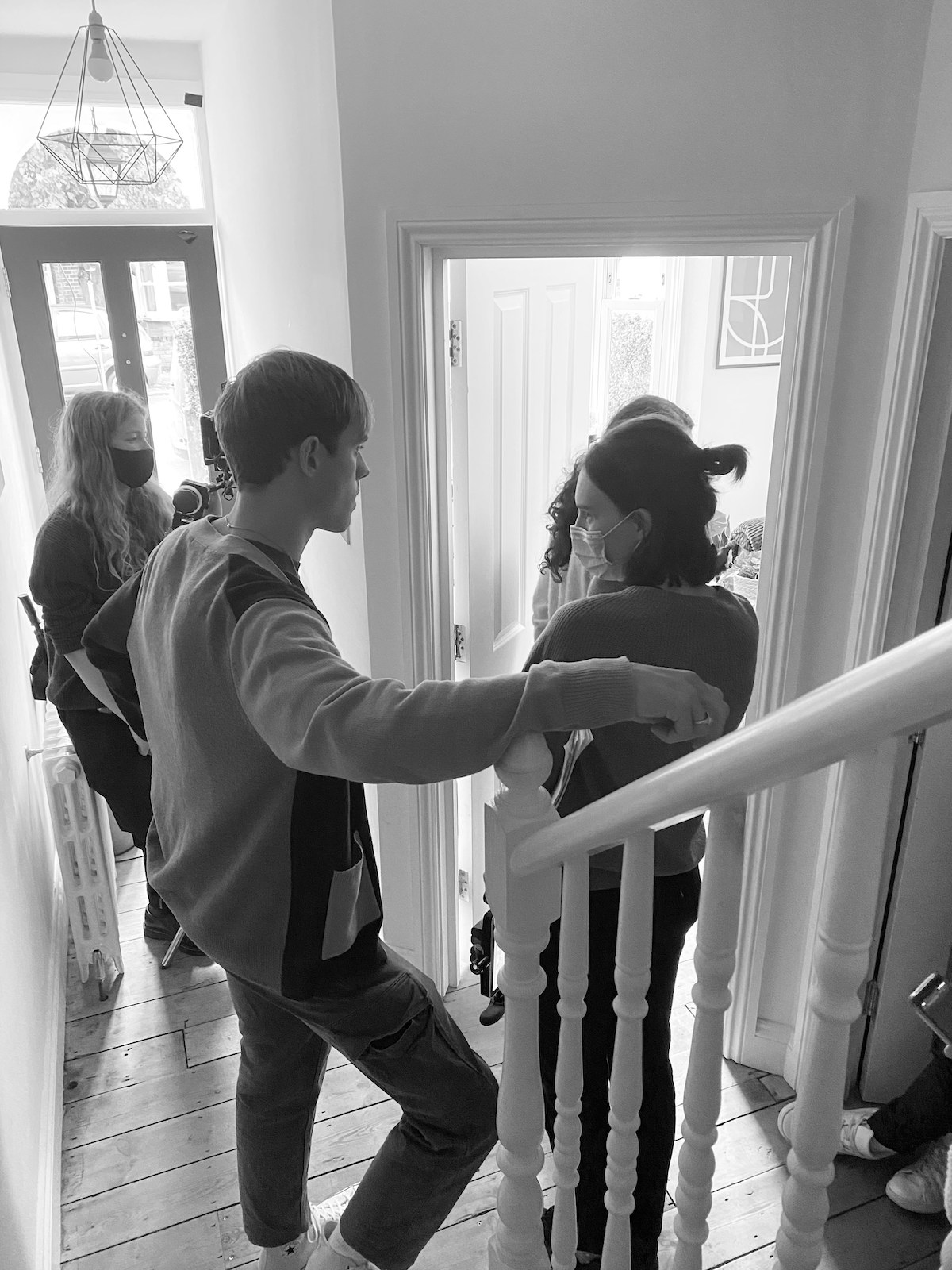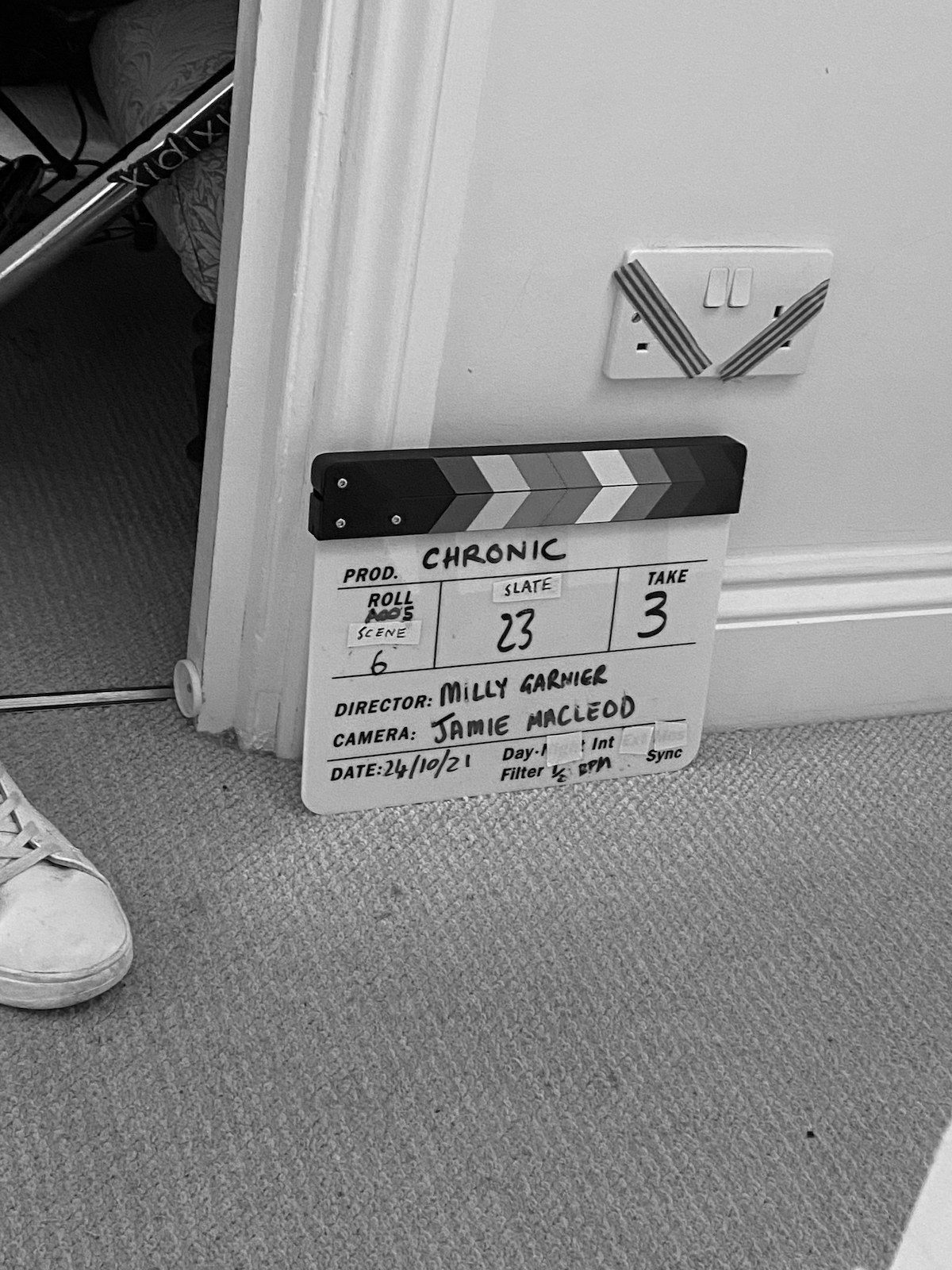How often do you see chronic illness or disability portrayed on your screens? The answer is, sadly not as often as we should. In fact, disabled people are the most under-represented group in television, both on and off screen.
In this episode, we explore how accessible the industry is as we speak to screenwriter Charlotte Paradise. She’s behind the short film ‘Chronic’ which follows a chronically ill woman as she moves in with her boyfriend for the first time.
Charlotte herself lives with chronic illness, so we spoke about the highs and lows of the industry, what it’s like to tell such a personal story on screen, and how they endeavoured to make this an accessible process from start to finish.
So whether you want to get into the industry, or you simply want to see more representation on your screens, we hope this episode will get the conversation started.
Below you can find links to the episode, as well as a transcript. If you scroll to the bottom of the page, you can find some curated links that may be helpful.
Where to listen:
Natasha: Hello, and welcome back to the Rest Room, the podcast about living well with chronic illness. I’m your host Natasha Lipman.
Let’s start this episode with a question.
What do the films Love and Other Drugs, the Fault in our Stars, and the Theory of Everything have in common?
They all explore the theme of chronic illness. These are blockbuster films with million dollar budgets, huge production teams, and a cast made up of Hollywood actors.
But how accurately do they reflect what it’s truly like to live with a chronic illness? And how many people working behind the scenes of these films actually live with the day to day realities?
Usually media portrayals tend to fit into one of three boxes. There’s the happy ending where the sick person makes a full recovery. There’s the terminal illness that we see in films like the Fault in Our Stars and My Sister’s Keeper. And then there are the medical dramas where doctors in the Seattle Grace Hospital of Grey’s Anatomy or House’s hand-picked team stay up all night trying to find a diagnosis.
When done properly, they can be educational, insightful, and moving. But more often than not, we see portrayals that aren’t representative, factually correct, or are full of harmful stereotypes, as we saw in the backlash to the film Music earlier this year.
In this episode, we’ll be exploring how chronic illness is portrayed in TV and film. We’ll also talk about how accessible the industry is.
This episode has come about because of a conversation I had with Charlotte Paradise. Beyond having a bloody excellent name, she’s a screenwriter, and she also lives with chronic illness. She’s behind the short film, Chronic, which is a project, like many, that was started during lockdown.
Charlotte told me what the film’s about.
Charlotte: Basically Chronic is about a couple, one of whom, Sadie, has a chronic illness.
So Sadie and Rob is the couple in the film. And they are just moving in together, which is something that they had been planning to do for a long time, but didn’t expect to be in a situation where they were moving in with Sadie having a chronic illness.
She hasn’t been diagnosed yet. So it’s not about a chronic illness in particular, but it basically moves through the first week of them moving in together and navigating a flare up that Sadie has.
And I think I wrote it probably for two reasons, or on two levels.
On a personal level, I had recently broken up from a very important romantic relationship in my life, basically ended. And I think writing Chronic, in hindsight, now I can see how much I was trying to process what had happened for me.
But also on a wider level, I asked myself a very big question. If I only had 10 to 15 minutes of screen time left, what film would I write? What is the story that really matters to me? And the last seven years of being disabled has been obviously huge and a huge change for me in my life. And I’ve felt very misunderstood. I’ve had a lot of relationships and friendships end. And yeah, so much of your life changes when that happens to you.
And I’ve come across so many people, a lot more people than I than I thought I would, who when I explain my illness, or I’d talk through my experience with diagnoses and misdiagnoses, I’m really surprised by how many people have gone, “Oh my gosh, I know someone who had that. It’s really hard.” Or even family members. “My sister has that.” Blah, blah, blah.
And there is so many of us experiencing such similar thing, and yet all feeling so alone. And I thought if I could write something and produce something with people who I trust to tell that story, we could help people feel less alone. But also the people who are caring for people like me to feel less alone as well.
Natasha: How did you go through the writing process? How did you go from the spark of the idea to having the script?
Charlotte: I think because it was over a year ago now that I actually wrote the script, it’s quite difficult to remember what came first.
I think when you’re writing something that’s just 10 minutes, I found it really difficult to not want to… I wanted to tackle everything. So I wanted to like write my whole experience as someone else’s experience in 10 minutes.
Which was just never going to happen. So I had to consciously think big, and then pare it back a lot. And writing the story and talking it through with Antonia really, really helped me because I kind of couldn’t just get carried away and write a feature film.
I often start my pieces with images. That’s where I go. So I tend to go to Pinterest. I feel like all of my writing should be sponsored by Pinterest. Because I just go there first and find images that tell the story I want to tell, if that makes any sense. I think deciding that the story was going to be about a couple in a very specific scenario of moving in together and deciding that it would be over a week, helped me have like four walls of the story to kind of build and play with.
So I just thought, well, where does the story start? The story starts with them walking through the front door for the first time.
And there were certain things that I felt were important to the story. There’s a scene where she goes to the doctor. And because, like you say, with an invisible condition, it’s quite difficult to show things and explain things.
The doctor scene is actually one of only two scenes that aren’t in their flat.
I just thought that that scene was really important to me because the moment where I had a doctor’s appointment, and the doctor couldn’t tell me what was wrong with me, was extremely frustrating. And I wanted to explore how the person who’s sick and the person who loves the person who’s sick deal with that in different ways. So there was certain things that I wanted to look at and pick apart, and see it played in front of me that I just ran with.
Natasha: And these are things that you generally just don’t see at all. You see people talking about it on YouTube or on Instagram, or kind of on social media, but it’s not really something that you get to see very much in popular culture, or anything like that.
When it comes to just the writing process in general, does your health have an impact on your ability to write? I can see you smirking. And if so, kind of how do you navigate going through that while trying to write?
Charlotte: I’m smiling because this has been a theme of my therapy sessions the last couple of weeks.
I think the last three or four weeks, my health has been on the lower side of normal. So kind of that place of not the worst, not the best. Some days I’m just in bed. But a lot of preventative rest. And I find that really, really hard.
And it’s times like this and times when I can’t move my arms that I get really stressed would be the word I would use. Because my brain never switches off.
And as a creative person and an overthinker and an INFJ, I’m constantly thinking, which means I’m constantly creating. That doesn’t mean that everything I’m creating in my head is good, by any means. But when I’m lying around, my brain is kind of on overdrive, and I don’t have physical ability in my arms to be able to kind of get that out of my system. So I end up feeling really low and with a lot of pent up, I want to say it’s not energy, because I don’t have any energy.
Natasha: It’s like creative energy.
Charlotte: Yeah. I guess. I just find it really frustrating when I’m having ideas, and I’m seeing pictures and things that I want to write down, but don’t have the means to.
And so in answer to your question, yes. I find that my health and my disability gets in the way of me being able to write whenever I want to. And also there’s the frustration of I’m writing and I’m in a flow, but I realise that I’ve been writing for two hours. And if I write anymore, I know I’m not going to be able to write for another two weeks.
Natasha: So how did Charlotte go about managing her own health during the process?
Charlotte: I have been very lucky in that. I didn’t have to use a lot of energy in finding producers because Antonia and another mutual friend of ours from our undergraduate is a producer.
So they have known me at uni, when I’ve been trying to do a degree and living on my own and being unwell and having flare ups and everything. They’ve seen all of that. So they know that I’m not going to be contributing, that kind of thing. And we’ve had some really amazing conversations about what doing this looks like for me.
And I mean, often in this industry, the writer writes the script, sells the script, or hands the script over. And then it’s like bye. Producers and directors aren’t often that interested in working with the director. Because this is my first film that’s been produced, and is also the first film that they are producing, there’s that balance between them knowing that I want to be a part of it. And also that I’m not going to be able to contribute too much practically. So we’ve had good conversations about my role and what that means.
And then we looked for a director. And this is the part of the story that I absolutely love. Just through mutual friends, ended up emailing Milly Garnier, and we just kind of left it very open, and said, “We’re looking for some advice for first time filmmakers. Could you tell us a bit about the directing process? We’ve attached our script. It’s about a couple navigating chronic illness. We’d love to just catch up over Zoom.” And she emailed us back and said, “I cannot believe you have just emailed me this. I had ME growing up. And this story is really close to my heart.” And it was just an incredible moment.
So yeah, like I said, I feel very lucky because I know that the networking process is so inaccessible. And probably have the lockdown to thank for that because I didn’t have to go out to parties and meetings and conferences and talks, and everything like that to find like-minded people. Because that would’ve taken up a huge chunk of energy.
I think that there are so many different levels of how the industry isn’t accessible. But I think if we want what’s on our screens to be more diverse in terms of chronic illness and disability, then there has to be the doors open for people like me to be able to get involved. And that always starts with networking.
Natasha: Hearing from Charlotte about the lack of accessibility in the industry doesn’t really come as a shock.
It’s no secret that those who are lucky enough to have secured a job in film or TV work long, long hours, are often on their feet all day carrying heavy equipment, dashing between sets and dressing rooms with few, if any breaks.
It’s not really conducive to a person living with a chronic illness or disability. But to be honest, talking to totally healthy friends in the industry, it’s not really conducive to just a healthy or balanced life for anyone.
This is actually something I have personal experience of, having worked as a runner and then a production manager for a photographer.
While it was not film or TV, everything I just mentioned sounds all too familiar. I remember taking a few hours off one evening to go out with my dad, and I sat there physically shaking because I knew I still had more to do.
It was physically and emotionally exhausting, and a truly toxic work environment. Eventually heading up the production on a photography book during such a short period of time, whilst under a huge amount of pressure, wore me down so much I had to move back home with my parents before quitting because I couldn’t handle it anymore.
Disabled actors, media professionals, and expert contributors have long been underrepresented in the industry.
The latest report from the GLAAD Media Group suggests that the number of series regular characters with a disability in the US has once again had a slight increase, but the 3.5% severely underrepresents the actual population living with disabilities.
And according to a 2020 report published by the UK’s Creative Diversity Network, disabled people are actually the most underrepresented group in television. Making up just 5.2% of the offscreen workforce and 7.8% on screen. That’s despite the overall figure for working age disabled people in the UK being around 17%.
The reports also say that disabled people are shut out of the industry. Charlotte agrees and wants to see that changed.
Speaking before the film was shot, she told me a bit more about how she and the team behind Chronic wanted to make the process as accessible as possible.
Charlotte: Things like offering positions. It’s actually quite funny. It’s making me smile because we want to have runners, and even the word runners is not great. So we want-
Natasha: We’re going to put gentle walkers instead.
Charlotte: We have gentle walkers and rollers. Usually people have runners on set to make coffee and run around and do errands. And so that people who aren’t yet established in the industry can see what it’s like, and if they want to do it and then network on set and meet people in the industry.
Those positions are just not possible for people with chronic illnesses and disabilities. And so we’ve been talking about having “runners.” We need to come up with a different name. I think we should do that.
And we just briefly talked about it recently, and I said to the producers, “Okay, so the stereotype is runners make tea and coffee. But not a thing.” If I were to be on set, my capabilities on a good day would be sitting down on set watching, and maybe being able to do a task or two because all of my energy would’ve been on getting there and getting home. If we give people tasks, how can we check in before what their access needs are, and whether they’ll be able to do them?
And things like offering half days rather than full days. Because it’s like, yeah, you’ll be the runner on set. And it’s like a month on set five days a week. It’s not possible. So yeah, offering drop-ins. You can come for a couple of hours, and then go just so that you can get the experience of being on set. Things like generally making the shooting time a bit longer than we would probably need so that if people need to take breaks, then that’s a possibility.
Natasha: Did you hire actors who also have chronic health conditions?
Charlotte: None of our actors do have chronic health conditions. No. We have, more than not people, who have had experience with, or know people who have experiences with chronic health conditions on team. But we are constantly having conversations about it. None of our decisions are made without it in mind.
Natasha: What would’ve made it easier for you to kind of get to the place where you felt like you could write a script, be in this industry, with your health condition?
Charlotte: The first thing that just came to mind was if someone put a call out and said, “We want someone who is chronically ill and visibly disabled to come and help us with this project.” The specific call out for someone like me would be great in an ideal world.
Natasha: When you said that, I was thinking about, there are so many things that I see, and I’m like, oh, this would be great, but it probably wouldn’t be accessible. And then I’m like, I can’t be bothered to go through the process of seeing whether it would be accessible only to know that in 80% of the cases, even if they said it would, it wouldn’t be.
So is that kind part of the reasoning behind it that you kind of if somebody has specifically put a call out for it that, that you know it’s going to be taken into consideration in kind of “a better way” than just having to kind of go in without knowing whether your needs will be met or not.
Charlotte: Yeah. That would be amazing. Things like I’ve been applying for lots of jobs and lots of freelance work recently.
And there’ve only been a few examples, but when job descriptions, that they even just name disability, it makes a huge difference in my confidence in applying for things because I know that it’s considered and even people asking what my access needs would be for interviews, things like that.
I mean, this industry is so hard to get into. There’s a very small percentage of people who “make it.” And so it’s very hard for everyone to do well. But it’s especially hard obviously for the people who can’t even get in the door-
Natasha: Literally.
Charlotte: … to be considered, literally, to be considered for that small percentage of people who make it.
Natasha: So did filming go to plan? I was lucky enough to catch up with Charlotte afterwards, and I think it is fair to say that she was absolutely beaming.
Charlotte: Oh, I get emotional just thinking about it still like a whole week on. Okay, generally filming was incredible. I feel like it was really successful. We got everything we needed to get. All the filming technically went brilliantly. But kind of more importantly, it was really beautiful and really special. And I know this is a big claim, but I think one of the best weekends of my life.
I feel really lucky to say that. Yeah, really emotional about it. I just think that because the story is so personal to the crew, and because they were all so passionate about it, there was this really special unspoken bond between everyone. As well as there being this healthy pressure to want to do this story justice. So this great balance between loads of fun, really great connection, but also really hard work and focus. Which was very important considering we only had two days to shoot the whole thing. So yeah, generally amazing. Amazing. I loved every second.
Natasha: That’s so nice to hear, especially because you put so much time and work into all of this. How long was it from conception stage to filming? When did you start?
Charlotte: Technically you could say it started when I first got sick about seven and a half years ago, I guess. Because everything I was going through was leading up to me writing Chronic. But really, I wrote the first draft, I think in April, May 2020. I actually found the email the other day that I first sent Antonia, who’s a producer and actor, of me sending her the first script, which was May 2020. So yeah, the email was so cute. I put in it like Chronic was the only title I could think of. Haha. And I just thought, ah, little did we know we’d be here like a year and a half later having done it. Yeah.
So long time coming. During a pandemic, during a lockdown, yeah, just wrote in bed in between flares. Yeah. It was really nice, and weird and surreal, to actually be on set after all of that time from writing it, to getting a team together, to all of our production meetings and everything. Yeah.
Natasha: The last time we spoke, we spoke a lot about kind of the plans that you were putting in place to make sure it was as accessible as possible, and kind of the different ways you were going to have to go about making a film as someone with a chronic illness. What was the kind of expectations versus reality of that when you actually got into the space and started filming?
Charlotte: Money. Making a film is really expensive. And we crowdfunded, and we were so grateful and did amazingly in our crowdfunder, and got enough money to film it and to film it well.
But one of the expectation reality things that happened was we wanted to film it over about five days so that we’d have a lot of room for conversation and resting, physically and emotionally. That just wasn’t feasible for us. So we had to film it in two days. Which was tight and meant that there was a lot of energy that needed to go into that.
Because we had to pay for a location which we hadn’t necessarily thought that we would have to. But it was kind of a give or take thing because actually paying for a location meant that we had a bigger location. Which was really great because there was always somewhere to lie down on a sofa or a bed. But yeah, I would say that was probably the biggest expectation reality things.
There were lots of other things that I didn’t expect being on set, like practically and personally. So I’d never been on a set before. And I’ve always wanted to be on a film set. So I was kind of surprised by how, yes, filmmaking is so creative, but it’s also really technical. There’s a lot of waiting around whilst they’re changing camera angles and stuff like that. So a lot more room, which is actually really helpful for someone who obviously isn’t part of making those changes to rest in between takes and things like that, which I wasn’t really expecting.
Natasha: How many people during the filming process did you have on set who were chronically ill, or disabled, or both?
Charlotte: In the end, it was me. So when we talk about expectations versus reality, we had planned, even a couple of days before shooting, to have had more chronically ill/disabled/both people on set in roles like production assistant and things like that.
And unfortunately it didn’t work out because you know what it’s like when you have a chronic illness. Even things like when you’re invited to a party, it’s great to be invited to the party, but you kind of let your friends know that I have to see how I am on the day or a couple of days before. Because of chronic illness and flares and health stuff that came up, that wasn’t possible. So on the day it was me. I feel really proud that those opportunities were in place, even though they didn’t end up happening.
Natasha: From a kind of managerial production level, how were you able to work around that? Because obviously it can be difficult for employers to be flexible and to have plans in place if somebody can’t show up. So what lessons did you learn? Did you have things in place to kind of help mitigate if that was going to be the case, which ended up being the case?
Charlotte: Yeah, definitely. We had like “backup plans.” Well, I say we. I had nothing to do with that. Our amazing producers did. Yeah. We had other people already signed up to give us a hand on set in those roles in case those happen. Because we know that there’s a level of inevitability and unpredictability with chronic illness.
Natasha: I’m delighted to say that this episode is sponsored by one of my very favourite theatres, The Old Vic.
You can book tickets now for their production of A Christmas Carol, Matthew Warchus’ big hearted smash hit production of Charles Dickens’ immortal classic, joyously adapted for the stage by Jack Thorne.
Described in a five star review by Time Out in 2019 as “magical.” They also said, “If the message of A Christmas Carol is God bless us, everyone, then this is theatre in which inclusivity is centre stage and the perils of denying it are all around you.”
They’re running access performances of A Christmas Carol on the following dates:
An audio described performance on Friday the 10th of December at 7:00 PM, with a touch tour at 5:15 PM.
They also have a relaxed performance which will be audio described and captioned on Saturday the 11th December at 1:00 PM, as well as a caption performance on Monday the 13th of December at 7:00 PM.
You can also sign up to be an Access Member of The Old Vic. As an access member, you’ll be able to buy tickets online for all performances, including wheelchair spaces, and pick the best seats in the house to suit your requirements.
For example, front row or aisle seats are the best seats to view captioned units or hear the audio description. The Old Vic will also keep you up to date with all of their access news and more.
Visit oldvictheatre.com for more information.
Welcome back. So after filming Chronic, Charlotte wrote about the film in her column for the Hysteria Collective. It touches on recent findings by the International Alliance of Theatrical Stage Employees, which calls out unacceptable work conditions and inhumane hours in the film and TV industry, with potential strike action imminent. She says this could be the perfect opportunity to expose the lack of accessibility and disabled representation on film sets, and to finally make a change.
Charlotte: I’ve been looking a lot and reading a lot about the film and TV union. And they’ve done this Instagram page about how dreadful the film and TV industry is, and how awful they are to their crew. And the strikes and everything.
And a lot of that talks about people being sick. Crew members from makeup artists to cinematographers to production assistants, getting sick and shoving it away to prove that they can master the industry. There’s this thing where to be on film sets, you have to be kind of indestructible and inhuman because time is money, and you can’t say that you’re not well.
And that’s awful for people because people are ending up getting really sick because they’re pushing away symptoms and stuff like that. And it just shouldn’t be like that. No workplace should be like that whether you are chronically ill or not.
So I guess I have some hope that in those things changing, and realising that we are all human and we all have bodies that can get sick suddenly. We don’t plan when we get sick, do we? That if that can happen for non-disabled people, then it could hopefully create some more room for disabled and chronically ill people to be on set.
Natasha: And what you were saying at the beginning in terms of the money versus time issue, that’s one of the major sticking points, right? That if everything has to be done quick, quick, quick, and there are things that need to be put into place, that something has to give. And what is that thing that has to give, it’s generally got to be more money. Or am I misreading that?
Charlotte: It’s like with a lot of things. The solutions very rarely come from the people at the top, but they actually need to.
So the productions that have the biggest budgets actually could be the ones paving the way because they’re the ones that have the resources to make a change, and have backup plans and have people on hold. And they’re not doing that for non-disabled people even.
It’s really hard, and I’m not a producer. And I guess it’s kind of easy for me to say we could do this and we should do this, and make things more accessible. But budgets are tight. They are. They’re so tight. And it’s just like doing the best with what you have, I think.
Natasha: Let’s hope this is the change we need to see in the industry. Before we say goodbye, I want to briefly head back to the set of Chronic. Charlotte told me a bit more about the experience of seeing her writing come to life and the lasting impact that’s had on her.
Charlotte: I actually had a flare on set watching the scene of the character flaring, which was a whole weird Inception existential moment for me. But that was probably the moment in my life where I’ve been out in public and flared, and felt the most safe and comfortable in my body, to kind of let that happen physically and emotionally.
I could physically go and lie down, and ask for water and ask for meds, and all of that kind of thing. And also I knew that everyone got it, that I didn’t have to explain it, and that they would be there for me. And that environment, that safety, and that togetherness and understanding and empathy, I think empathy is really the best word for it, meant that we did get feedback from the other people on set saying that it was safe and it felt like a privilege almost to be making a film that was something that really mattered to them.
And there was a sense of catharsis in doing it, in working through all the feelings that come with loving someone who has a chronic illness.
And also for the people who were involved who don’t have a personal connection to chronic illness or disability, feeling like there was an honour to learn. They felt honoured to learn about it and to be a part of a project, yeah, that was special, and that really mattered. And that’s not very common in the industry. There are loads of, you do jobs to do jobs obviously, because you have to live. And a lot of those aren’t… A commercial for example, or things that aren’t really important or about advocacy. So yeah, I think for both chronically ill, disabled, and non-disabled people on set, we got really great feedback on how great a weekend it was. People just used the word lovely a lot. Like it was just lovely. And I’m just probably going to keep saying lovely. But it was really warm. Everyone was in it together, and that felt really special and safe.
Natasha: See, I was going to say that sounds lovely. How was it for you just watching the filming taking place, seeing this story that you wrote kind of coming to life? How did that feel? What was it like?
Charlotte: People can’t see because this is a podcast and not video, but I’m putting my hands to my face, I’m pulling my cheeks around. I couldn’t have predicted what emotionally it would be like to be on set and to watch them film such a personal story in front of me.
I think it was probably life changing for me a lot more than I expected. I felt so many emotions. I didn’t expect to feel so many emotions at once.
There was so much grief and so much joy. I was chatting to a friend actually a couple of days after because I woke up the morning afterwards, and I just sobbed. But most of the day, it came in waves. I guess, I used the word cathartic earlier. It was like all these different waves kept coming of all of these feelings.
Because when I was on set and I was watching them go from scenes where the main character is really angry, to scenes where the main character is sobbing, to scenes where the main character is flaring, I mean props to the actors for going through all of those emotions. They were incredible. But I just like this overwhelmed, stunned kind of feeling. I was just stunned the whole way through. And then the day after I was like, all of the feelings came.
I was processing it with a really good friend of mine. And she put it really well. She said, “It sounds like you were in a space of death and creation. And that’s so contradicting, but so human.” And that is exactly how it felt. There was so much joy and pride in, oh, this is a story that’s being told. And this is so important. And I feel so proud to be a part of making this happen. This feels important. And also this is so fun because since I was five, I wanted to be on a film set and all of that.
But also there was some tough, tough moments. It’s not an easy breezy film. There are some scenes in there that are hard to watch, and were really hard to watch for me.
You know, chronic illness isn’t all doom and gloom. Yes, it’s really hard, but people who are chronically ill and disabled are still human. Actually, there are moments that are really funny about being chronically ill. There’s always humour. There have been moments where people closest in my life to me have had a laugh at how ridiculous I look or how funny it is. I’ve been so stubborn. I don’t want help eating, and that my hair looks ridiculous.
And there was this one time where I said to my mom, “Oh, I’ve just got so much brain frog today.” And then we just burst out laughing, and this brain frog was just hilarious. There are these funny moments and happy moments in it all.
And in TV and film, a lot of the time, narratives around disabled stories, they’re all hard and all about these limits and things that you can’t do. And not the rom com that just happens to have a disabled lead trying to get laid, or people just having a laugh.
And it’s really hard with Chronic, because it’s just 10 minutes. It’s just a short film, and actually, it was Antonia who in the drafts was like, “Hey, Charlotte, can we make it a bit happier?” I was like, “Oh, yeah. Okay, we can do that. We can make it happier.”
But annoyingly, just the way that things go on set, we ran out of time, and we had to cut some scenes last-minute, and it was those scenes that ended up having to go. And I find it hard that you can’t capture the whole experience of living with chronic illness in 10 minutes. It just doesn’t work.
And it would’ve been great to have those moments where they were able to do things together or they were able to have a proper laugh. I mean, there are glimmers of those moments in there, but I think it’s really important, going forward, in writing longer-form stuff, feature films and things, and TV shows, that disabled people are people and can have a laugh. And that there is humour in it all.
I was listening to a podcast with Jameela Jamil and Sophie Morgan, and Sophie Morgan was saying how people are shocked that she can be a bitch. “You are disabled, and you’re not just inspiring and perfect. That you actually have sex and can be a bitch. And you swear.” And it’s things like, “Oh, we’re just people. We can have a laugh and be annoying and be divas, as well as being nice and “inspirational.”
Natasha: And it’s not just the humour, it’s also those tiny details. After our interview, Charlotte told me a story that highlighted just how important it was for her, as someone with chronic illness, to be in the room while filming happened.
On the last day, trying to keep to their very tight schedule, they were filming a scene not long after Sadie had her hair washed. The actress’s hair was wrapped in a towel, when Charlotte pointed out that there was no way that Sadie would be able to handle the weight of a heavy towel on her head.
Accuracy was important, but time was running out. They didn’t have time to wet her hair, so after some back and forth they decided that she would keep the towel, but she would be leaning her head against the headboard of her bed, struggling with the weight of it.
It’s a small detail, perhaps one that many people won’t notice. But it represents the more subtle impacts of chronic illness, the things that can make the supposedly invisible, visible, if we only look more carefully.
And, as Charlotte told me, it’s those details, those moments of reality, that can be missed, when the people who are being represented aren’t included in creation.
Charlotte: But I think it felt life changing because of how empowering it was. Wasn’t expecting to feel empowered necessary, but watching them do the scenes that were really personal to me, physically and mentally. Aspects of what it looks like for me living with a chronic illness, seeing that right in front of me, was really vulnerable and really exposing. And you are in a room of 15 other people who you, yes, feel safe and they get it, but also all of them know that I wrote it and that this is about me. And that was really vulnerable.
But why I wrote Chronic is because I think, when you have a chronic illness or dynamic disability, a condition that fluctuates and it is mostly invisible, you get a lot of people who they only see you or socialise with you when you’re on a good day. So when you try and explain the realities of your chronic illness and what it’s like for you physically, people get confused. Because they’re like, “Well I saw you on Monday, and you looked so great. And you were moving around and all of those things.” People don’t get to see you on a hard day. So being in that room on set and not just being seen as Charlotte on a good day when I’ve got spoons, but also the person who flares behind closed doors, was very emotional, but also very empowering.
And I felt like I could be seen by the people on set, the people who are going to watch the film, and also myself. It feels like a defining moment in me being able to accept my disabled identity. And Chronic is a sort of pledge to myself that I’m not going to hide anymore, that I’m going to be seen.
Natasha: You’re going to make me cry.
Charlotte: I’ve been crying all week. I’ve been crying all week. And I’ve got goosebumps, which is in part to do with this medication I’m taking, which gives me goosebumps. Weird side effect. But yeah, I felt like I levelled up.
I levelled up in my acceptance of who I am. And even in the process of writing this with Antonia, who is such a good friend of mine, who I met the year before I got sick. So she’s known me the whole time that I’ve been disabled. But I haven’t let her in, and I haven’t let a lot of people in. Because I felt so much shame of what I look like and feel like when my…
So one symptom that I get is that my arms just go. I just can’t move them. And what that means, that I can’t eat properly. And in writing the script and Antonia reading it, but also in having conversations with her about what it feels like and what it looks like when that happens, it’s really pushed me out of my comfort zone.
And I’m so glad that I’ve done that, and that I got to see it happening on set right in front of me. Because it’s like, oh, that’s me. That’s actually what I look like. And I don’t get to see what it looks like when I’m exhausted and get out of bed. Watching it, I was like, oh, that looks exactly how it feels.
And actually I showed a clip, a sneaky video I took on set of that scene happening, of her getting out of bed in a flare. And I showed it to my mum. My mum burst out crying. She was like, “That is uncanny. That’s exactly what it looks like.” And so it was an opportunity for me to see what I look like and allow other people to see that too. And it felt, yeah, life changing is a big word, but it felt life changing.
Natasha: How do you feel about this now going out to the public?
Charlotte: Ahhhhh! I’m so mixed.
There is that part of me that’s like, oh my gosh, what have I done? This is terrifying. And I think that that happens with all art. There’s so much vulnerability in sharing and putting it out into the world.
But I feel hopeful. The word that comes to mind is hope. I’m excited. I’m excited for people to hopefully feel the way that I felt watching it on set. That like, oh, I can take up space and I can be seen. And I am seen, and I’m not alone in this.
And it’s not just a story about the person who’s chronically ill, but also the partner of her, her partner. And I’m excited for carers and partners to also feel seen. I don’t know. I feel like the phrase coming together. I’m excited for us to come together. People who I’ve never met who are going to watch this film and feel like there was a coming together, if that makes any sense.
Natasha: What a positive and uplifting message to end on.
Charlotte says the film is currently being edited and there’ll be a digital release very soon. So keep an eye on their Instagram @chronicfilm for updates.
A huge thank you to my guest, Charlotte Paradise for letting us look behind the scenes of Chronic. I really can’t wait to watch. I have a feeling I’ll need some tissues at the ready.
A special thanks to our sponsor, The Old Vic. To learn more about their access performances and Access Scheme, don’t forget to visit oldvictheatre.com. We’ll actually be discussing access and the theatre with the Old Vic in our next episode. So keep an eye out for that in December.
If you enjoyed what you heard and want a heads up about future episodes, please subscribe to the Rest Room wherever you get your podcasts.
Please rate and leave a review as that really helps new people find us. And share the episode on your social media. You can find me on Instagram and Twitter @natashalipman.
That’s all for me in a very chilly London. Thanks for joining me in the Rest Room. Ta-ta for now.
This podcast is produced by OG Podcasts. Find out more at ogpodcasts.co.uk.
Episode art by Lucy Dove.


